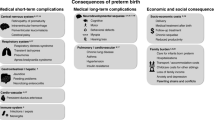Abstract
Spontaneous preterm births occur as a consequence of spontaneous preterm labor or preterm rupture of fetal membranes before the onset of labor. Preterm parturition is not necessarily the result of premature physiologic activation of processes that normally occur at term; rather, preterm labor commonly results from pathologic processes.
Interventions employed to improve the outcomes in symptomatic patients may be consider as a tertiary intervention. Tertiary interventions involve regionalized perinatal care, optimum timing of indicated preterm birth, and use of tocolytic agents, antenatal corticosteroids, and antibiotics. The main objective tertiary intervention is to reduced perinatal morbidity and mortality.
This chapter focuses on therapeutic strategies for treatment of spontaneous preterm labor and delivery.
Access this chapter
Tax calculation will be finalised at checkout
Purchases are for personal use only
Similar content being viewed by others
References
WHO. 2015. WHO recommendations on interventions to improve preterm birth outcomes. Geneva, Switzerland: World Health Organization. Retrieved from http://www.who.int/reproductivehealth/publications/maternal_perinatal_health/preterm-birth-guideline/en/.
ACOG Committee Opinion No. 579 (Reaffirmed 2019): definition of term pregnancy. Obstet Gynecol. 2013;122(5):1139–40.
Green NS, Damus K, Simpson JL, Iams J, Reece EA, Hobel CJ, Merkatz IR, Greene MF, Schwarz RH, March of Dimes Scientific Advisory Committee On Prematurity. Research agenda for preterm birth: recommendations from the March of Dimes. Am J Obstet Gynecol. 2005;193(3 Pt 1):626–35.
Goldenberg RL, Culhane JF, Iams JD, Romero R. Epidemiology and causes of preterm birth. Lancet. 2008;371(9606):75–84.
Lockwood CJ, Berghella V, Barss VA. Pathogenesis of spontaneous preterm birth. https://www.uptodate.com/contents/pathogenesis-of-spontaneous-...th/print?search=preterm%20labour&topicRef=6798&source=see_link.
Copper RL, Goldenberg RL, Das A, et al. The preterm prediction study: maternal stress is associated with spontaneous preterm birth at less than thirty-five weeks gestation. Am J Obstet Gynecol. 1996;175:1286–92.
Hähle A, Merz S, Meyners C, Hausch F. The many faces of FKBP51. Biomol Ther. 2019;9:35.
Bloomfield FH, Oliver MH, Hawkins P, Campbell M, Phillips DJ, Gluckman PD, et al. A periconceptional nutritional origin for noninfectious pre- term birth. Science. 2003;300:606.
Romero R, Espinoza J, Kusanovic J, Gotsch F, Hassan S, Erez O, Chaiworapongsa T, Mazor M. The preterm parturition syndrome. BJOG. 2006;113(Suppl. 3):17–42.
Romero R, Dey SK, Fisher SJ. Preterm labor: one syndrome, many causes. Science. 2014;345(6198):760–5.
Lockwood CJ, Kayisli UA, Stocco C, et al. Abruption-induced preterm delivery is associated with thrombin-mediated functional progesterone withdrawal in decidual cells. Am J Pathol. 2012;181:2138.
Phelan JP, Park YW, Ahn MO, Rutherford SE. Polyhydramnios and perinatal outcome. J Perinatol. 1990;10:347–50.
Besinger R, Carlson N. The physiology of preterm labor. In: Keith L, Papiernik E, Keith D, Luke B, editors. Multiple pregnancy: epidemiology, gestation and perinatal outcome. London: Parthenon Publishing; 1995. p. 415.
Martins C, Godycki-Cwirko M, Heleno B, Brodersen J. Quaternary prevention: reviewing the concept. Eur J Gen Pract. 2018;24(1):106–11.
Iams JD, Romero R, Culhane JF, Goldenberg RL. Preterm birth 2. Primary, secondary, and tertiary interventions to reduce the morbidity and mortality of preterm birth. Lancet. 2008;371:164–75.
Simhan HN, Caritis SN. Prevention of preterm delivery. N Engl J Med. 2007;357:477–87.
Norwitz ER, Saade GR, Miller H, Davidson CM. Preterm labor in obstetric clinical algorithms, 2nd edn. John Wiley & Sons, Ltd.; The Atrium, Southern Gate, Chichester, West Sussex 2017. p. 150–2.
Simhan HN, Caritis S. Inhibition of acute preterm labor. https://www.uptodate.com/contents/inhibition-of-acute-preterm-labor.
Berger R, Abele H, Bahlmann F, Bedei I, Doubek K, Felderhoff-Müser U, Fluhr H, Garnier Y, Grylka-Baeschlin S, Helmer H, Herting E, Hoopmann M, Hösli I, Hoyme U, Jendreizeck A, Krentel H, Kuon R, Lütje W, Mader S, Maul H, Mendling W, Mitschdörfer B, Nicin T, Nothacker M, Olbertz D, Rath W, Roll C, Schlembach D, Schleußner E, Schütz F, Seifert-Klauss V, Steppat S, Surbek D. Prevention and therapy of preterm birth. Guideline of the DGGG, OEGGG and SGGG (S2k Level, AWMF Registry Number 015/025, February 2019) - part 2 with recommendations on the tertiary prevention of preterm birth and the management of preterm premature rupture of membranes. Geburtshilfe Frauenheilkd. 2019;79(8):813–33.
Hubinont C, Debieve F. Prevention of preterm labour: 2011 update on tocolysis. J Pregnancy. 2011;2011:941057.
Simhan HN, Caritis S. Management of pregnant women after resolution of an episode of acute idiopathic preterm labor. https://www.uptodate.com/contents/management-of-pregnant-women-afterresolution-of-an-episode-of-acute-idiopathic-preterm-labor?search=preterm%20labour&topicRef=6798&source=see_link.
National Institute for Health and Care Excellence (NICE). Preterm labour and birth. London: (UK); 2015 Nov. www.nice.org.uk/guidance/ng25.
Author information
Authors and Affiliations
Editor information
Editors and Affiliations
Rights and permissions
Copyright information
© 2022 Springer Nature Switzerland AG
About this chapter
Cite this chapter
Moreira de Sá, R.A., da Fonseca, E.B. (2022). Prematurity: Relevant Aspects in the Symptomatic Patient. In: Moreira de Sá, R.A., Fonseca, E.B.d. (eds) Perinatology. Springer, Cham. https://doi.org/10.1007/978-3-030-83434-0_32
Download citation
DOI: https://doi.org/10.1007/978-3-030-83434-0_32
Published:
Publisher Name: Springer, Cham
Print ISBN: 978-3-030-83433-3
Online ISBN: 978-3-030-83434-0
eBook Packages: MedicineMedicine (R0)




